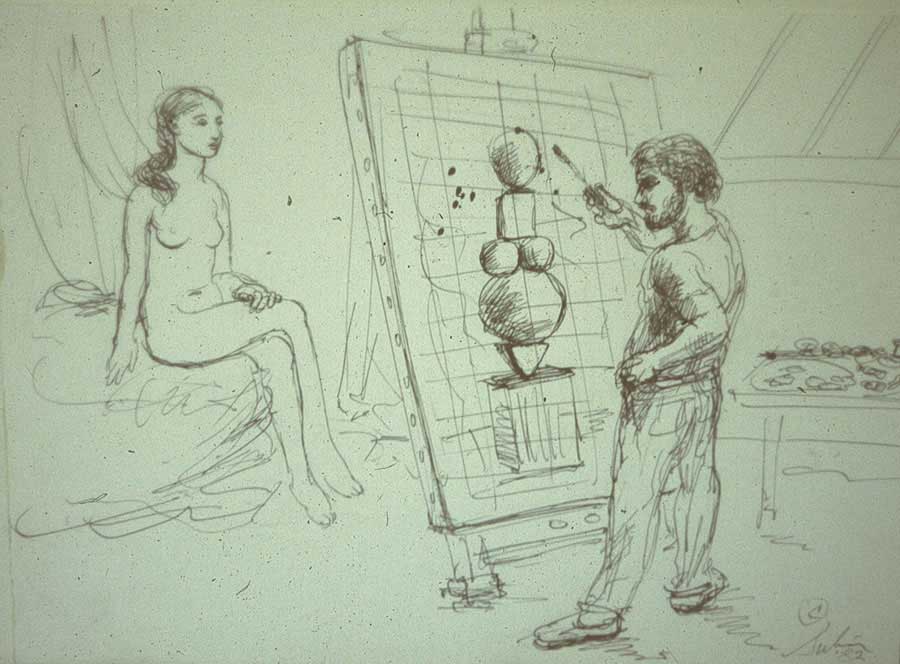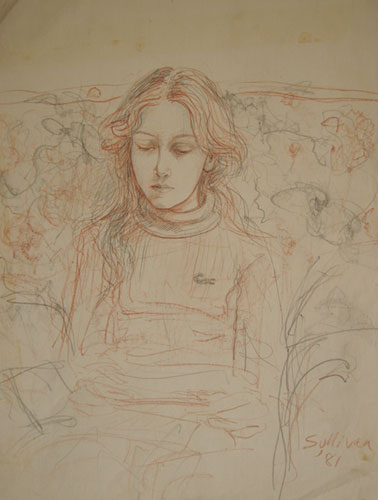Modernism and Figurative Art

Critique of Modernism, Pen and ink, 1982, collection of the artist.
This drawing, from 1982, ironically shows that the Modernist invention is more important than any connection with life and its beauty, that is right before the artist in the form of a live model, the kind of reality which has inspired artists for centuries.
The Philosphy of Rene Descarte initiated a dualism, a split between mind and body, soul and body, in 1619 that has only recently with “The Theology of the Body” of Pope John Paul II been revised with a philosophy and theology that restores the body to its rightful importance. The attack on the body has had a profound influence on art in Modernism leading to abstract art and the disembodied art that is Conceptual Art. Descarte’s “Cogito, ergo sum.” -“I think, therefore I am.” was his way of finding the certitude that he searched for in 1619. The only knowledge that he trusted was the fact that he thought. He rejected sense knowledge, as well as knowledge from politics, religion, and opinion, as being unreliable. With that view Modernism was born. Its characteristics have been 1. Subjectivism, (everyone is an artist) 2. Rationalism, science is prized over artistic knowledge, 3. Dualism, privilege of mind over body, separation of mind and body 4. Anti-Traditionalism, lets tear it down and start over.
Professor Michael Waldstein in the introduction to his translation of Pope John Paul II’s The Theology of the Body points out that a “…truely bottomless pit is opened only by the Cartesian universe with its complete indifference to meaning. Matter is “mere matter”, sheer externality. It is Value free. The reason for this indifference of matter to meaning lies in the rigorous reconstruction of knowledge under the guidance of the ambition for power over nature.”
Professor Waldstein goes on to say, “The scientific rationalism spearheaded by Descartes is above all an attack on the body. Its first principle is that the human body, together with all matter, shall be seen as an object of power. Form and final cause must therefore be eliminated from it. The response to such a violent scientific-technological attack on the body must be a defense of the body in its natural intrinsic meaning. The spousal mystery is the primary place at which this defense must take place, because the highest meaning of the body is found there.”
Waldstein quotes the philosopher pope countering Descartes’ dualism. John Paul II- “The philosopher who formulated the principle of “cogito, ergo sum”-I think, therefore I am- also gave the modern concept of man its distinctive dualistic character. It is typical of rationalism to make a radical contrast in man between spirit and body, between body and spirit. But man is a person in the unity of his body and spirit. The body can never be reduced to mere matter; It is a spiritualized body, just as man’s spirit is so closely united to the body that can be described as an embodied spirit.” 1.
Father Robert Barron said in his lecture at the Napa Institute Conference 2012 that “Postmodernism has broken the log jam of Modernism”. He says that postmodernism gives us space and he mentioned the Postmodern, Post-liberal theologian Urs Von Bathasar who said that “beauty changes us”. He went on to explain how the “Theology of the Body” of John Paul II is a reversal of Descarte’s attack on the body.
John Paul II, Man and Women He Created Them, A Theology of the Body, Translated by Michael Waldstein, 2006.
On a personal note, the drawing above was an acknowledgement of my realization that I lived in a time when traditional art was despised. There were no commissions for altarpieces, so I decided to master my craft by making studies from life, like the many portraits of my family. That body of work has become an important part of my art.

Rachel Reading, pencil and red lead, 1981.
See also:
On Sacred Art
Caravaggio’s Raising of Lazarus, Symbols and Stories (The Theology that started Abstract Art), Italian Insider Newspaper, Rome, July 16, 2012.
Caravaggio and the Aesthetics of Meaning , September 27, 2011.